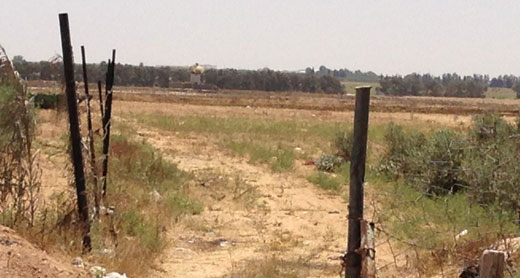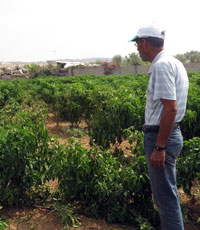IDF's unmarked firing zone keeps farmers of Gaza off their land

An Israeli army vehicle rides along a security fence standing on the Gaza border with Israel, east of Khan Younis, in the southern Gaza Strip, during a demonstration by Palestinian youths on November 23, 2012. 21-year-old Abdelhadi Qdeih was killed. IDF soldiers kill 1 Palestinian, wound 19 others at Gaza-Israel border 2 days after ceasefire. Photo by Said Khatib / AFP.
GAZA STRIP
Military carries on firing at Palestinian farmers by Israel-Gaza border
Report by B’Tselem
October 29, 2013
After Operation Pillar of Defense (14-21November 2012) media reports stated that, as part of the ceasefire agreement, Israel and Hamas had reached an understanding that Israel would allow Palestinians greater access to the farmland near the Israel-Gaza fence. These areas constitute roughly a third of all farmland in the Gaza Strip. On 8 February 2013 IDF magazine BaMahane reported that “Palestinian residents of Gaza have been granted permission to enter the security perimeter area up to 100 meters from the fence”.
Until that time, Israel had limited Palestinian access to areas near the border. As of 2010, the military had distributed leaflets several times throughout the Gaza Strip warning residents against coming within 300 meters of the fence. The leaflets emphasized that “anyone coming near [the fence] is putting himself in danger: all measures will be taken against anyone entering that range, including firing.” However, the prohibited areas along the fence were not marked, so persons entering the forbidden range were not always aware of the attendant risk.
‘Abd a-Rahman Abu Rajelah, 61, of Khuza’a, Khan Yunes Distirct, a farmer and father of eight, spoke to B’Tselem field researcher Khaled al-Azayzeh on 20 May 2013 and described the situation:

‘Abd a-Rahman Abu Rajelah. Photo by Khaled al-Azayzeh, B’Tselem, 20 May 2013
My brothers and I own 10 dunams [1 hectare] of land in eastern Khuza’a. Two dunams [0.2 hectares] are forty meters away from the fence, two are about 250 meters away, and two are 530 meters away. Until the year 2000, my family worked all those plots. We used to grow wheat, barley, almonds and figs. At that time, I was working in Israel and my brothers made a living from those plots. In 2006, the crossings between Israel and Gaza were shut down and I started farming, too…
[since then] We got nothing out of the four dunams that are closest to the fence. Also, the two dunams that are 530 meters from the fence were ruined by the military. Military bulldozers razed that land more than once in previous years. We used to have olive, apple and avocado trees there. Even after the last ceasefire in November 2012 [after Operation Pillar of Defense], I still can’t get to some of my farmland, because the Israeli military fires at anyone who gets as near as 150 meters from the border fence. To read full testimony click here.
Prior to Operation Pillar of Defense, B’Tselem and other organizations documented dozens of cases in which the military shot persons who were more than 300 meters away from the fence – sometimes as far as a kilometer and a half away. According to OCHA, in reality, Palestinians were denied access to 17 percent of the total land mass of the Gaza Strip, which includes approximately 35 percent of its agricultural land.
B’Tselem welcomed the easing of access following the operation, while stressing that the policy of live-fire as a method of deterrence is illegal, whatever the range of access allowed. Moreover, the military did not formally issue the new rules of access. It quickly became apparent that the easing of restrictions reported in the media was not realized in practice and that farmers and others entering areas close to the fence were still being shot at – even when further than 300 meters from the fence. According to B’Tselem’s data, since the end of the operation, the military has shot and killed four Palestinians in areas close to the fence, one of whom was riding a motorcycle some 300 meters away from the fence.
According to OCHA figures, up to 21 October 2013, 135 Palestinians were injured by live fire near the fence, including 54 in the week after the operation ended.

Uncultivated fields near the Gaza perimeter fence. Photo by Khaled al-Azayzeh, 28 May 2013
In May 2013, the Office of the High Commissioner for Human Rights (OHCHR) published a report examining access restrictions near the border. The report found that, overall, access to land more than 300 meters away from the fence is freer than before Operation Pillar of Defense. However, the report also stated that, in the period under review (20 February to 20 March 2013), most farmers could not cultivate land lying less than 300 meters from the fence, and some could not even work land further away. Moreover, in some cases, soldiers fired at farmers more than 300 meters from the fence who working their land with tractors and similar agricultural equipment.
As information regarding the range beyond which farmers can safely work their land remained hazy, Israeli NGO Gisha – Legal Center for Freedom of Movement applied to the IDF Spokesperson and to the spokesperson of the Coordinator of Government Activity in the Territories (COGAT) at the Ministry of Defense, requesting clarification. The responses received were contradictory. While COGAT claimed that Palestinians are have permission to be 100 meters away from the fence, the IDF Spokesperson’s Unit claimed that the safe range was 300 meters. A further response from the IDF Spokesperson’s Unit stated a different position, whereby “residents of the Gaza Strip are forbidden to come nearer than 300 meters from the security fence”, but also that, “based on a security evaluation and on coordination with COGAT, farmers can enter on foot in order to work certain agricultural lands within that area”.

Ribhi Shabat [above], 67, of Beit Hanoun, spoke with B’Tselem field researcher Muhammad Sabah on 1 October 2013 and related the difficulties he encounters when trying to work his land near the fence:
I cultivate a plot in Beit Hanoun that is about 400 meters from the fence. Another part of my land is 200 meters from the fence and I don’t work it at all, because of the shooting.
On Tuesday, 24 September 2013, I started working my plot at 6:15 A.M., as usual. There were other farmers in the area. They grow onions, tomatoes, potatoes, cauliflower and cabbage. At around 9:00 A.M. I was picking eggplant when I heard shots coming from the direction of the fence. I saw three military jeeps and next to them I saw soldiers and shooting in our direction. I didn’t know if they were aiming at us or at some shepherds who were closer to the fence. When the shooting didn’t stop, I ran from there with the other farmers. The shooting lasted for more than ten minutes. We didn’t go back to our plots that day because we were afraid there would be more shooting. I left several boxes of eggplants behind, because I was too afraid to go back for them.
Photo by Muhammad Sabah, B’Tselem, on 1 October 2013
As stated above, the agricultural lands close to the fence constitute roughly a third of all farmland in the Gaza Strip. The military’s conduct prevents farmers from working most of this land, due to the unclear rules and the threat of physical danger. Other residents who make a living off these areas and are also denied access include various occupations such as gravel and debris collectors. In this way, Israel unjustifiably harms the livelihood of tens of thousands of people.
B’Tselem reiterates that the military must enable farmers to work their land and that, if a security zone is necessary, it must lie within Israeli territory. As long as that is not the case, Israeli must spell out the precise boundaries of the restricted areas in the Gaza Strip. It must also refrain altogether from using live fire as a means for deterring civilians from entering those areas, using non-lethal methods instead. It is Israel’s right and duty to protect its border, but it must do so within the boundaries of the law and avoid harming persons who are not a security threat.
[The introduction to B’Tselem’s report on Gaza is in Gaza: drinking water is running out. Urgent petition]
